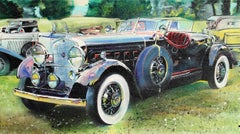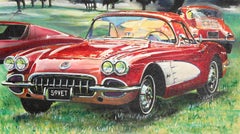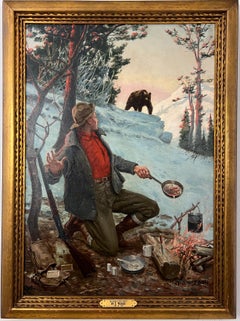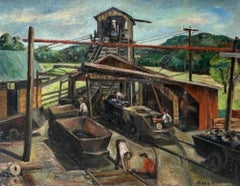John McCormick Figurative Paintings
American, b. 1949
John McCormick is an American Postwar and Contemporary artist renowned for his realist oil paintings of classic cars such as the Corvette, Rolls Royce and Thunderbird. He also painted beautiful landscapes, sailboats and still lifes. McCormick often signed his work in the lower center of the canvas. Born in 1949, he lived in Massachusetts. Numerous key galleries and museums such as Harris Harvey Gallery have featured John McCormick's work in the past. He has been active in the San Diego, New York and Seattle art scenes.to
2
Overall Width
to
Overall Height
to
2
2
2
2
2
2
1
1
2
2
2
2
3
467
321
258
227
1
2
Artist: John McCormick
Rolls Royce, Oil Painting by John McCormick
By John McCormick
Located in Long Island City, NY
Artist: John McCormick, American
Title: Rolls Royce
Year: 1983
Medium: Oil on Canvas
Size: 18 in. x 32 in. (45.72 cm x 81.28 cm)
Category
1980s American Realist John McCormick Figurative Paintings
Materials
Canvas, Oil
1959 Corvette, Oil Painting by John McCormick
By John McCormick
Located in Long Island City, NY
Artist: John McCormick, American
Title: 1959 Corvette
Year: 1983
Medium: Oil on Canvas, signed
Size: 18 in. x 32 in. (45.72 cm x 81.28 cm)
Category
1980s American Realist John McCormick Figurative Paintings
Materials
Canvas, Oil
Related Items
A Surprise Dinner Guest. Outdoorsman and Bear in Snowy Forest Camp Painting.
Located in Marco Island, FL
A dynamic narrative painting titled A Surprise Dinner Guest (or An Unexpected Guest), showing the moment an outdoorsman sees the bear approaching his snowy campsite. Presented in a...
Category
Early 20th Century American Realist John McCormick Figurative Paintings
Materials
Canvas, Oil
Industrial Railroad WPA Mid 20th Century American Scene Rural Modern Realism
By Louis Bosa
Located in New York, NY
Industrial Railroad WPA Mid 20th Century American Scene Rural Modern Realism
Large oil on canvas genre painting depicting laborers working on a railroad, with rural landscape in the...
Category
1940s American Realist John McCormick Figurative Paintings
Materials
Canvas, Oil
$11,500
H 29 in W 35 in D 3 in
God Bless Our Home, Social Realist Scene, Figurative Americana Interior Scene
Located in Doylestown, PA
"God Bless Our Home" is an interior and figurative scene of a woman sitting on her couch in serious and proper expression. The Americana style paint...
Category
1930s American Realist John McCormick Figurative Paintings
Materials
Canvas, Oil
$2,300 Sale Price
50% Off
H 24 in W 28 in D 2 in
Street of the Old Quarter British School signed Cade oil on canvas painting
Located in Sitges, Barcelona
**Technical Sheet**
**Title:** "Street of the Old Quarter"
**Author:** British School, 19th Century
**Date:** 1892
**Technique:** Oil on canvas
**Dimensions:** 14.17 x 10.63 inc...
Category
1890s American Realist John McCormick Figurative Paintings
Materials
Oil, Canvas
$650 Sale Price
54% Off
H 14.18 in W 10.63 in
"Old Shoemaker" Ashcan 20th Century Modernism 1924 California WPA Realism Worker
By Otis Oldfield
Located in New York, NY
"Old Shoemaker" Ashcan 20th Century Modernism 1924 California WPA Realism Worker. Signed “Otis Oldfield” lower left. 14 x 12 inches.
Exhibited: Galerie des Beaux Arts, San Francisco, CA, 1925
Provenance: Estate of the Artist
Born in Sacramento, CA on July 3, 1890, Otis Oldfield left high school at age 16 to work in a local print shop. In 1909 he arrived in San Francisco and enrolled at the Best Art School. After working for two years as a bellhop at the Argonaut Hotel and as a hat check boy at the Cliff House, he had saved enough money for further studies in Paris. In 1911 he sailed for France and enrolled at Académie Julian. Caught up in the activities of wartime Paris, he was an apprentice for a book...
Category
1920s American Realist John McCormick Figurative Paintings
Materials
Canvas, Oil
Portrait of a Lady, Oil on Canvas, 1840's, In Style of Jacob Eichholtz
Located in Doylestown, PA
This interior portrait of a woman dressed in an elegant lace shawl is a 30" x 25" oil on canvas painting in the style of Jacob Eichholtz. The artist is unknown but the painting is believed to have been painted in the 1840's. It is not signed but framed and in good condition. Provenance: Private Collection, Old Queens Gallery...
Category
Mid-19th Century American Realist John McCormick Figurative Paintings
Materials
Canvas, Oil
$750
H 34 in W 28 in D 2 in
“The Newspaper Boy”
Located in San Francisco, CA
The classic hard luck, independent kid, maybe 8 or 10 years old here, selling the day’s papers out on the grubby streets of early 1900s New York City. He’s paused in a quiet spot, ap...
Category
Early 1900s American Realist John McCormick Figurative Paintings
Materials
Canvas, Oil
Columbus Avenue NYC c. 1920s/30s American Scene Ashcan WPA Modern 20th Century
By Bernard Gussow
Located in New York, NY
Columbus Avenue NYC c. 1920s/30s American Scene Ashcan WPA Modern 20th Century
"Late Afternoon, Columbus Avenue, New York", impasto oil on canvas, signed lower left, signed verso (under relining, shown in photo), and titled verso on stretcher, in maple mitered cove frame, 23 1/4" x 27 1/4", SS: 19 1/4" x 23 1/4", Relined.
BIO
Russian-born Gussow trained at the Art Students League and the National Academy of Design. He also studied under Bonnat at the Ecole des Beaux-Arts in Paris. His first claim to fame was exhibiting two works at the Armory Show in 1913. Gussow exhibited at the Society of Independent Artists between 1917 and 1934 and at Salons of America in the 1930s.
The Whitney Museum of American Art, for example, has his Subway Stairs. The Barnes Foundation...
Category
1920s American Realist John McCormick Figurative Paintings
Materials
Canvas, Oil
Puddle Jumper. Woman With Umbrella Original Oil American Rainy Scene Painting.
Located in Marco Island, FL
An ordinary scene of a woman walking down a sidewalk in the rain is elevated to a little gem of a painting. American life is captured in this Clyde Singer painting, Puddle Jumper (...
Category
Late 20th Century American Realist John McCormick Figurative Paintings
Materials
Canvas, Oil
$3,500
H 15.5 in W 13.5 in
"Snowy City Scene" American Scene Social Realism WPA Era Mid-20th Century Modern
Located in New York, NY
"Snowy City Scene" American Scene Social Realism WPA Era Mid-20th Century Modern
Syd J. Browne (1907-1991)
"Snowy City Scene"
22 x 30 inches
Oil on canvas. c. 1930s
Signed lower lef...
Category
1930s American Realist John McCormick Figurative Paintings
Materials
Canvas, Oil
Calder Sculpture in Lincoln Center- New York City American Scene Painting
Located in Marco Island, FL
Clyde Singer was a master at capturing the moments, small and significant in everyday American life. This painting, "Calder Sculpture in Lincoln Center", is a glimpse of an ordinar...
Category
1970s American Realist John McCormick Figurative Paintings
Materials
Oil, Canvas
$14,000
H 34 in W 35 in D 2 in
London Round House-Mid-Century Industrial American Scene Oil Painting
By Jack Steele
Located in Marco Island, FL
A mid-century American Realist scene of children playing on the railroad entitled, London Round House. The chaotic scene of children rambunctiously playing is suspected to be set in...
Category
1940s American Realist John McCormick Figurative Paintings
Materials
Canvas, Oil
$14,000
H 52 in W 43 in D 3 in
Previously Available Items
1956 Ford Thunderbird, Oil Painting by John McCormick
By John McCormick
Located in Long Island City, NY
Artist: John McCormick, American
Title: 1956 Ford Thunderbird
Year: 1983
Medium: Oil on Canvas
Size: 18 in. x 32 in. (45.72 cm x 81.28 cm)
Category
1980s American Realist John McCormick Figurative Paintings
Materials
Canvas, Oil
John Mccormick figurative paintings for sale on 1stDibs.
Find a wide variety of authentic John McCormick figurative paintings available for sale on 1stDibs. You can also browse by medium to find art by John McCormick in canvas, fabric, oil paint and more. Not every interior allows for large John McCormick figurative paintings, so small editions measuring 32 inches across are available. Customers who are interested in this artist might also find the work of Derek Buckner, Benjamin Stahl, and Anthony Ackrill. John McCormick figurative paintings prices can differ depending upon medium, time period and other attributes. On 1stDibs, the price for these items starts at $9,500 and tops out at $9,500, while the average work can sell for $9,500.




